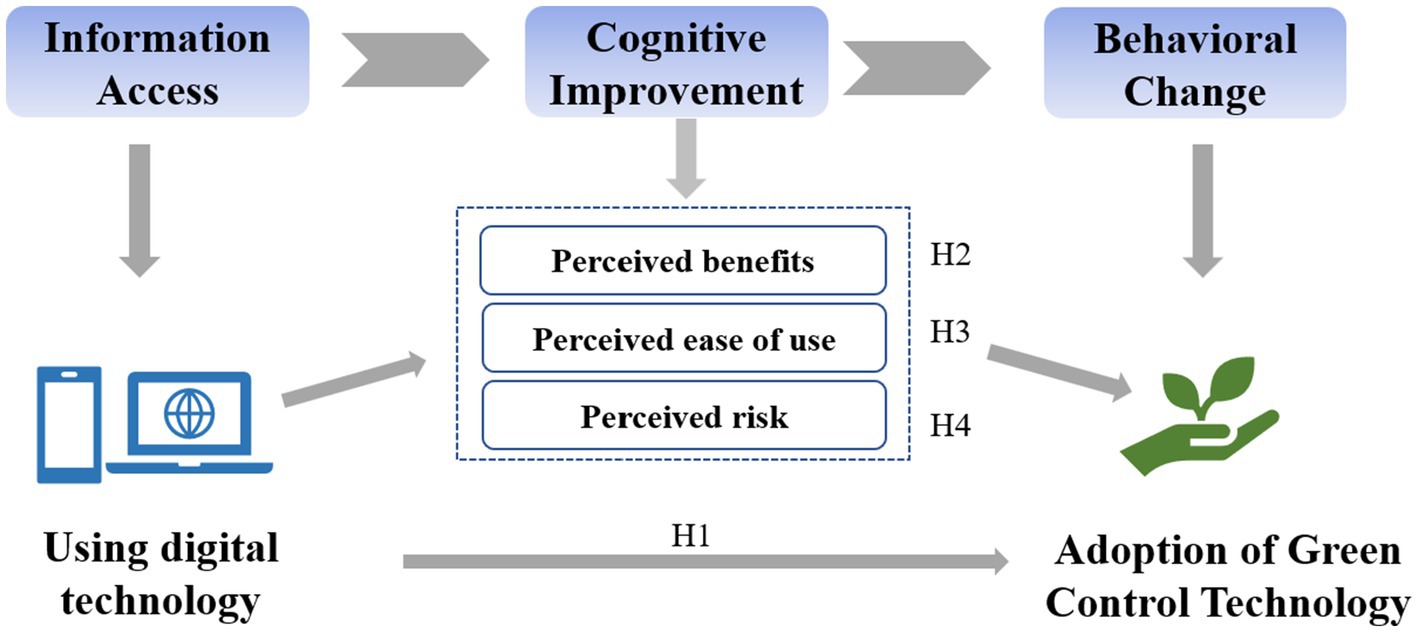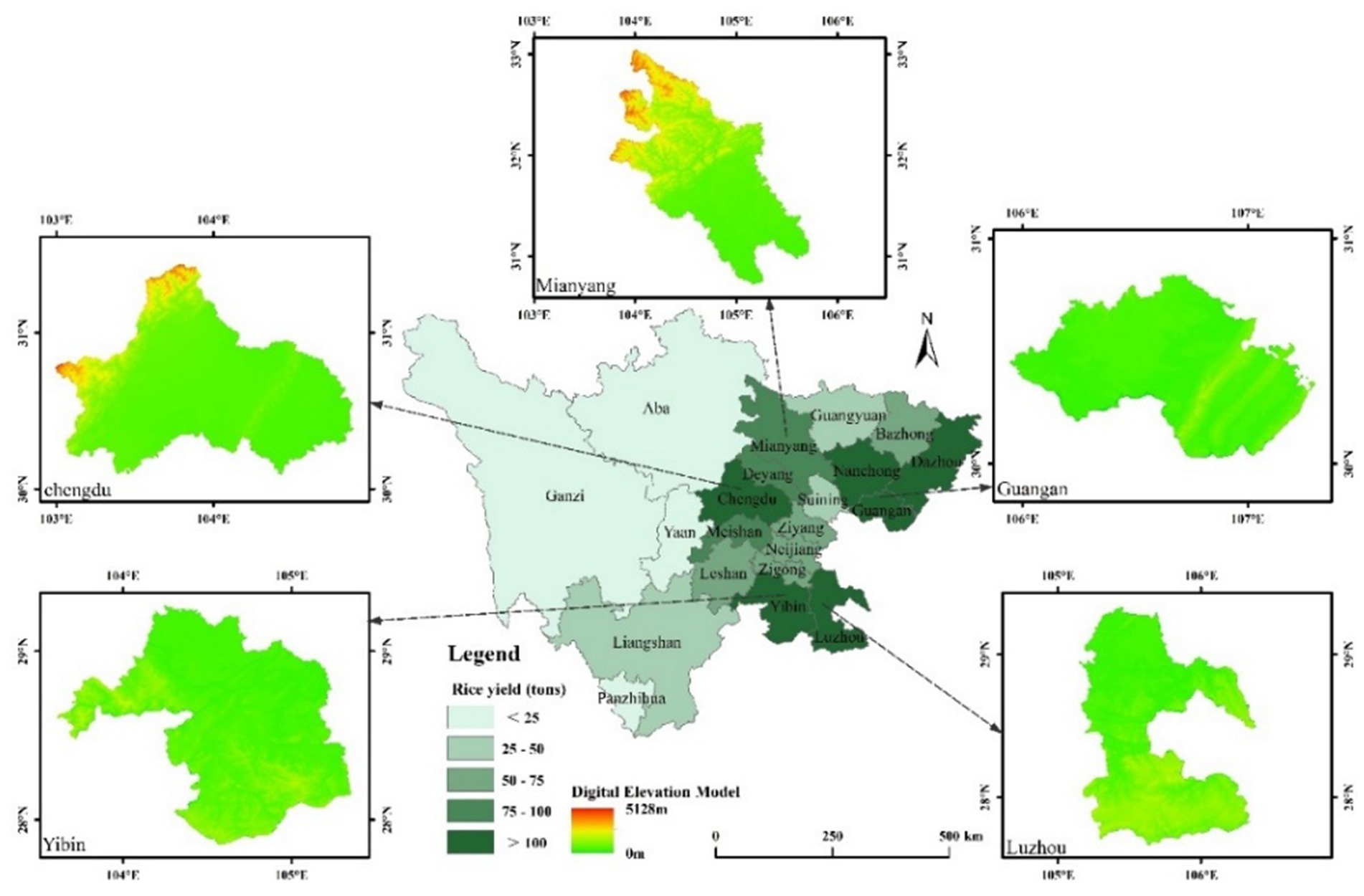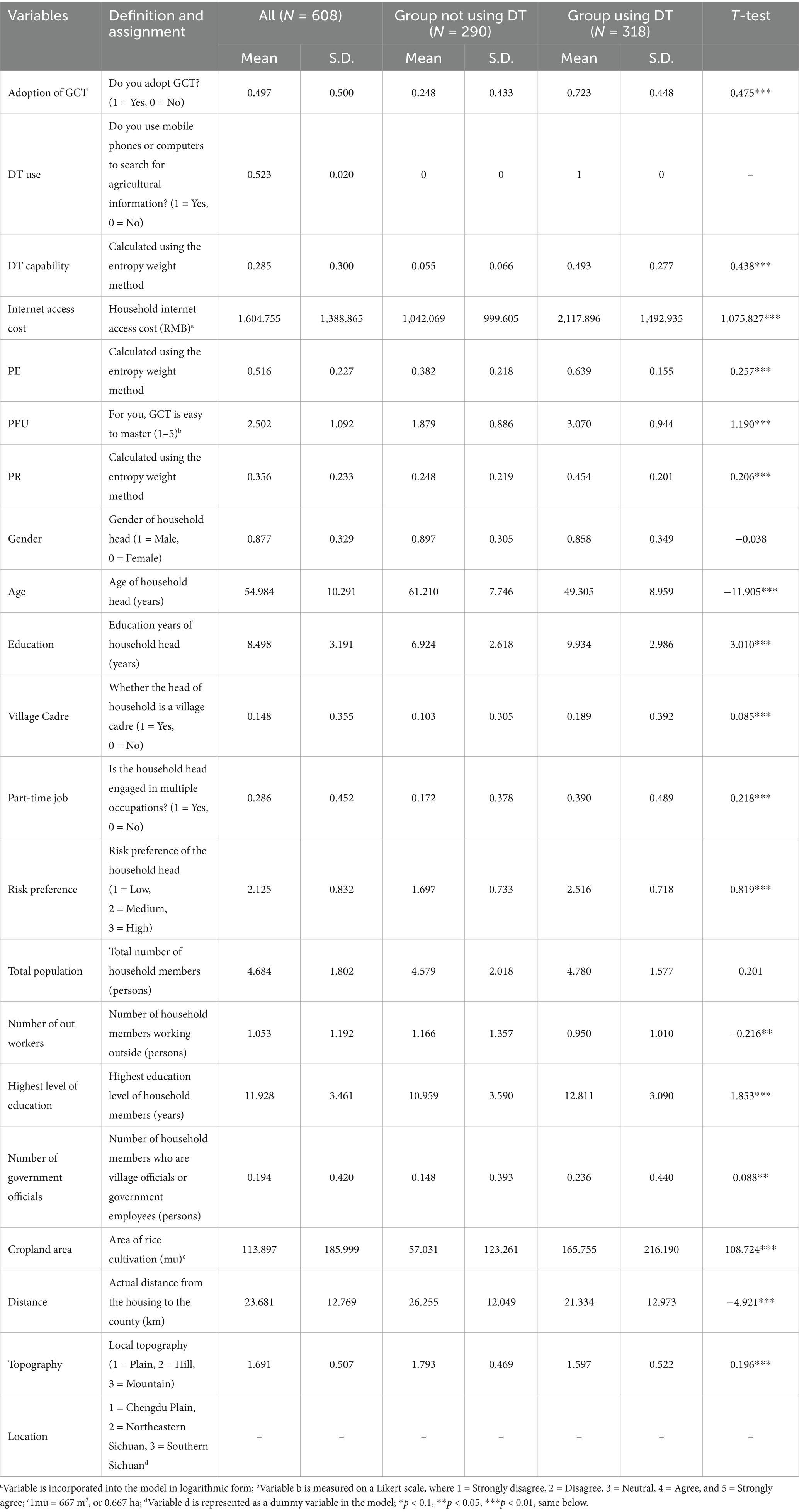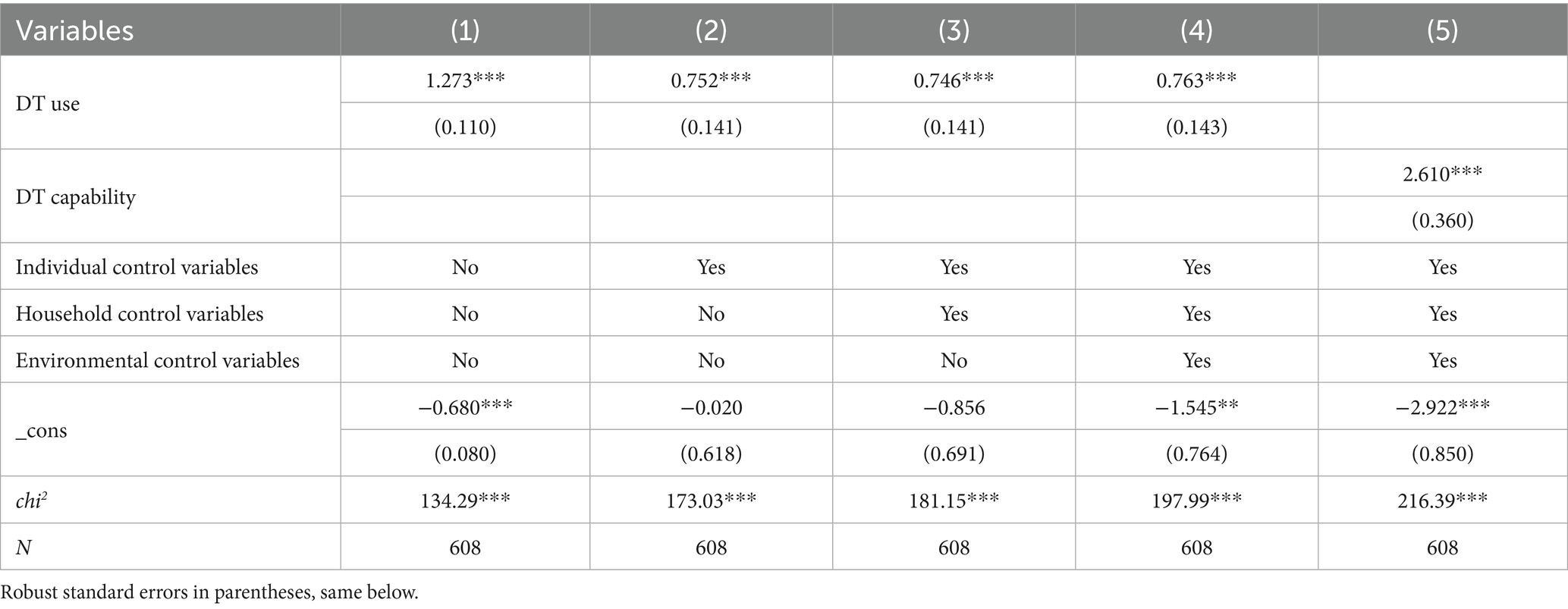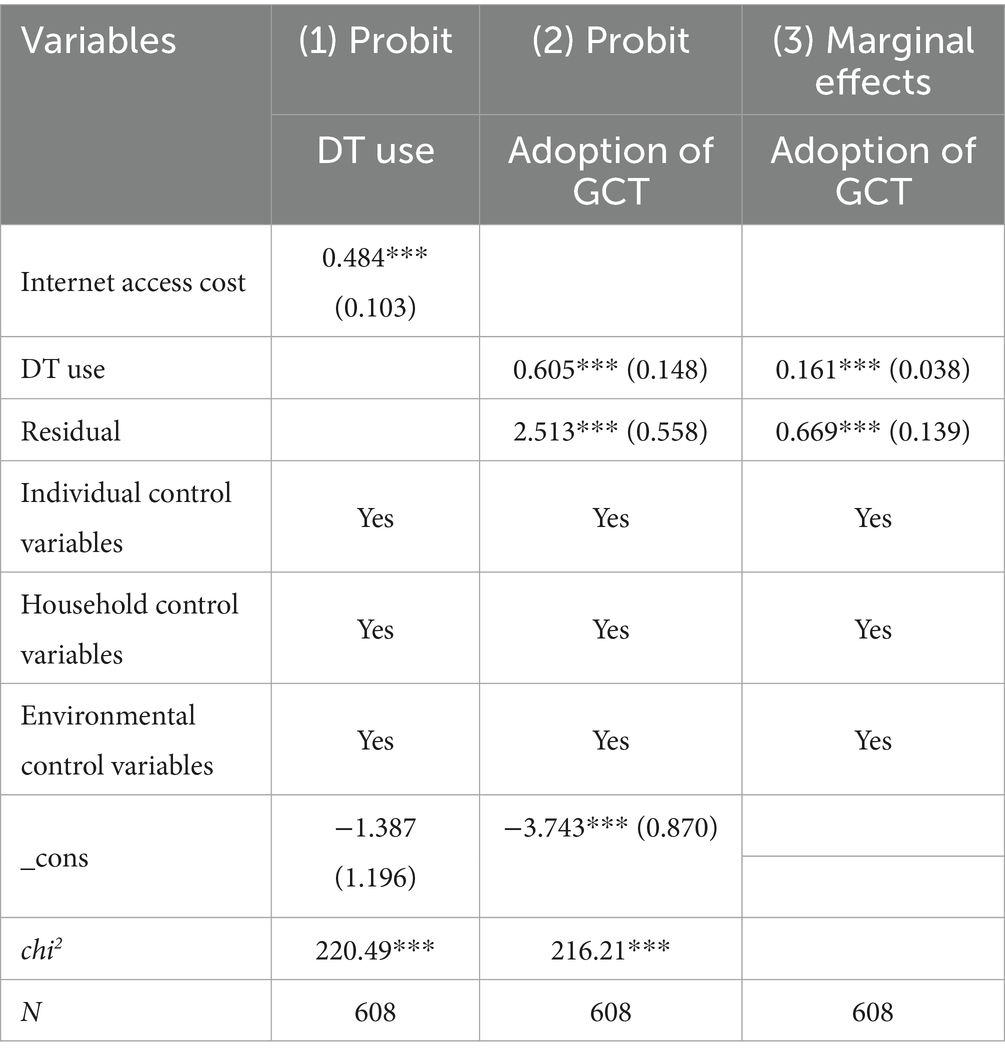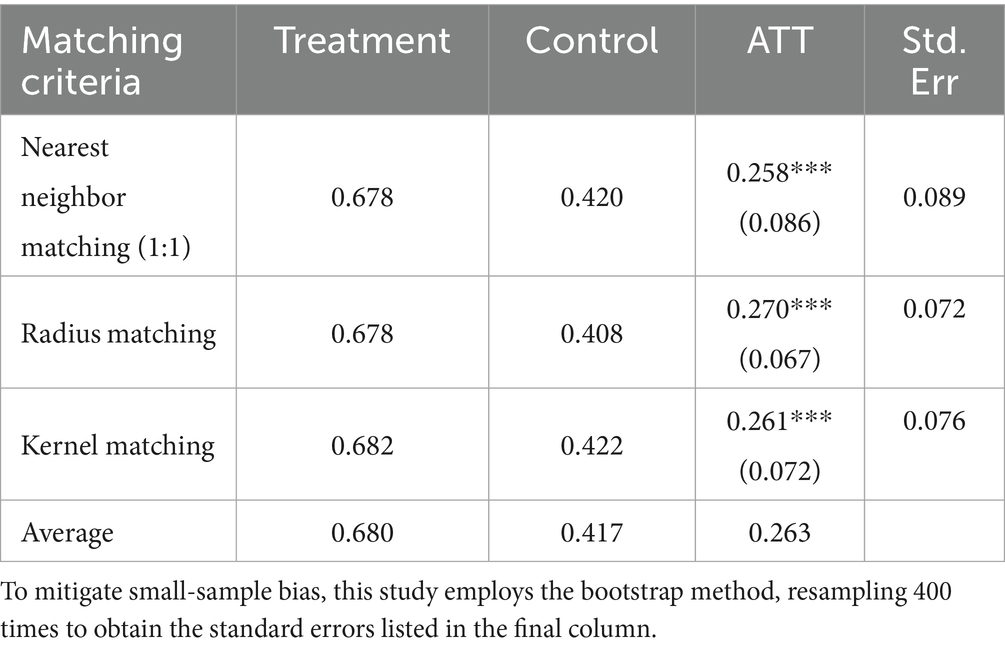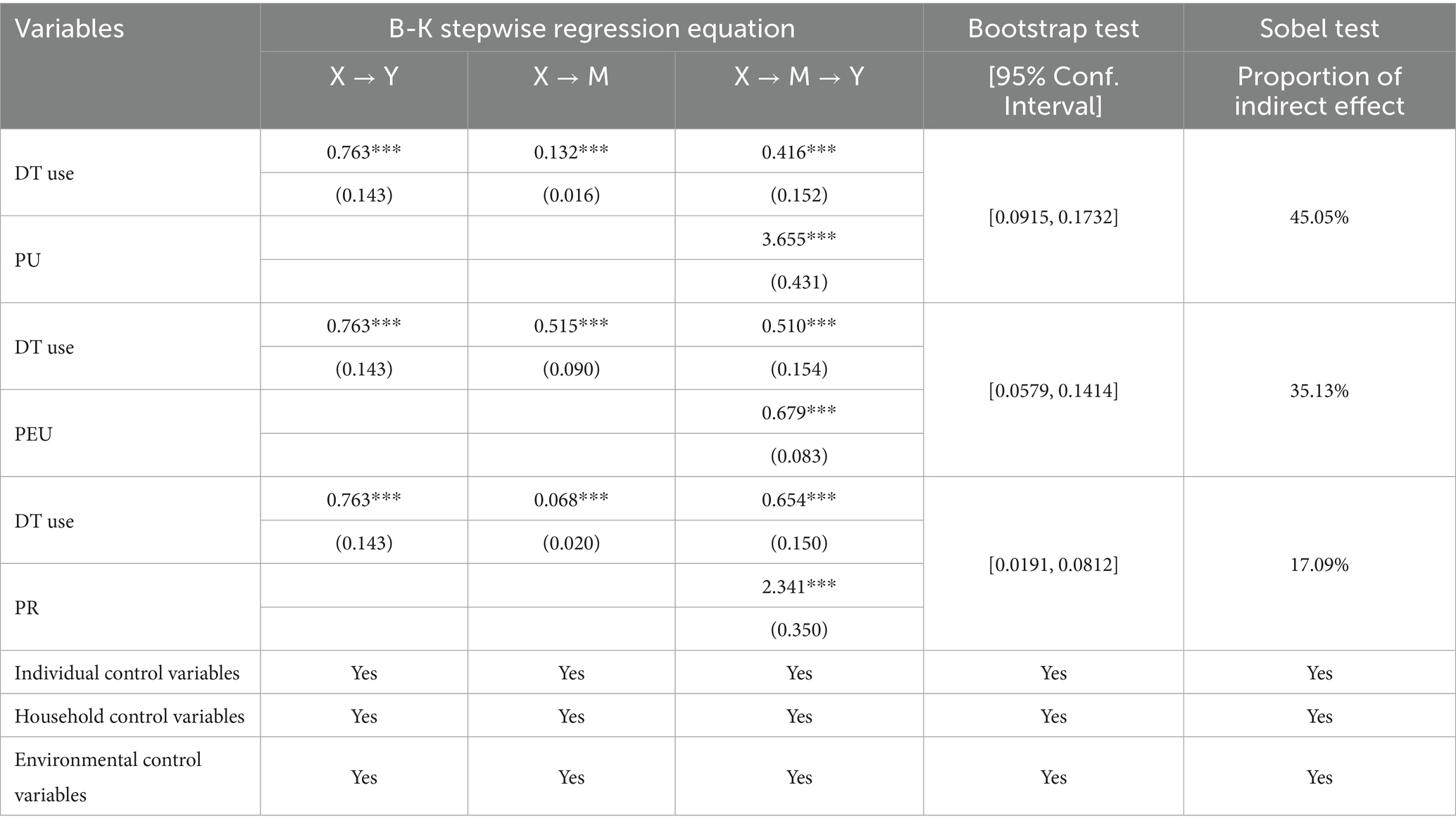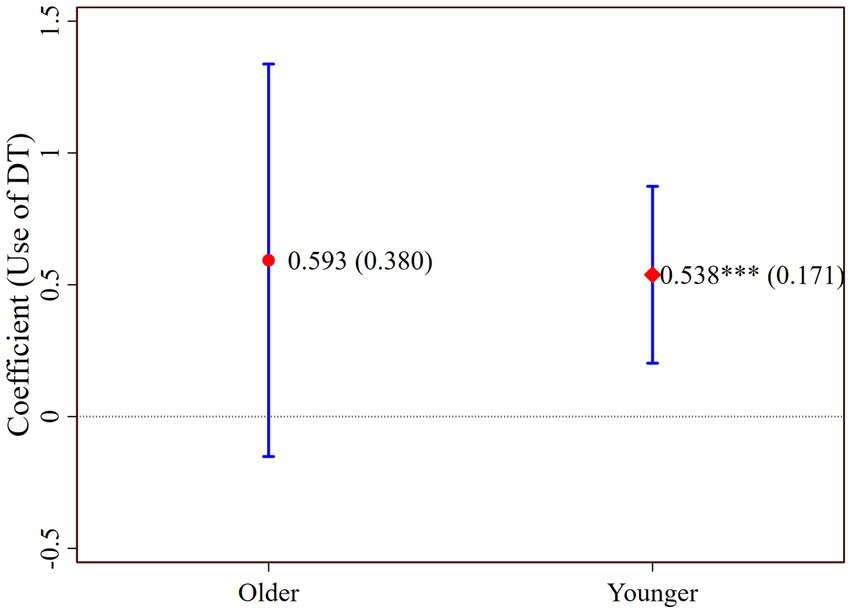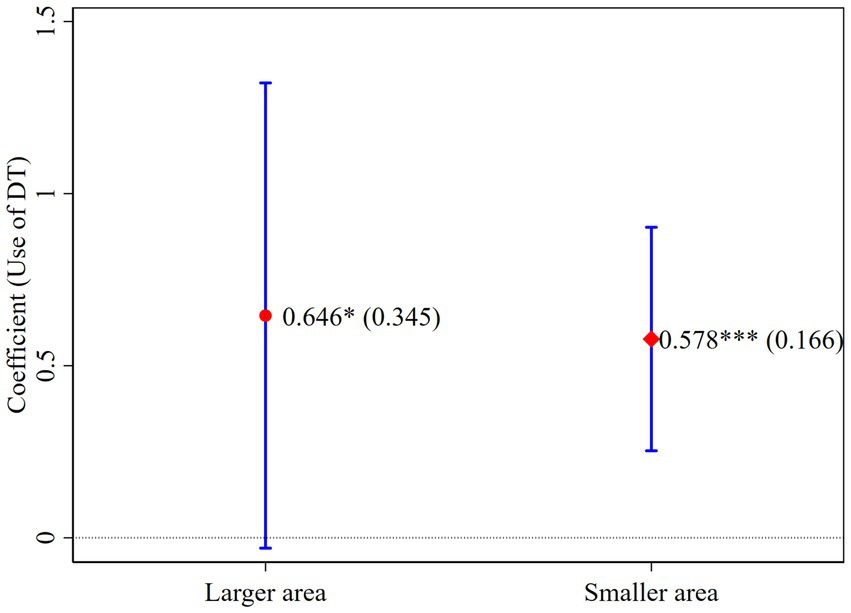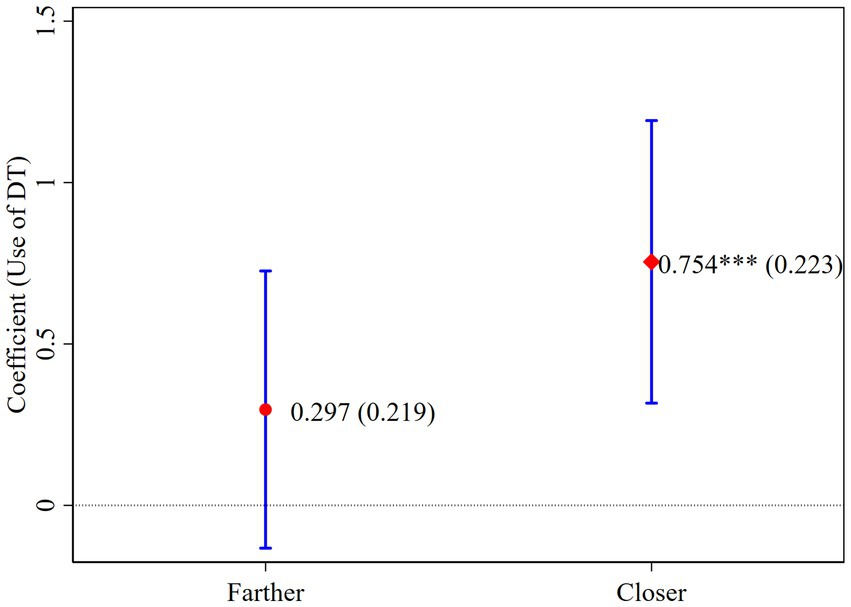- College of Public Administration, Sichuan Agricultural University, Yaan, China
The lack of technical information is widely regarded by researchers as a significant barrier to the promotion of green technologies. However, with the extensive application of Digital Technology (DT) in the rural and agricultural sectors, the way information is transmitted in rural areas has undergone a fundamental transformation, which also brings an opportunity for the promotion of green agricultural technologies. Taking Green Control Technology (GCT) as an example, based on the survey data of rural households in Sichuan, China, this study empirically examines the association between the use of DT and the adoption of GCT using a binary Probit model. Results indicate that, the use of DT significantly promotes the adoption of GCT among farmers, leads to an average increase of about 16.1%. During this process, farmers’ perceived usefulness, perceived ease of use, and perceived risk of GCT serve as mediators, the mediation effect accounted for 45.05, 35.13, and 17.09%, respectively. The impacts of DT also vary across groups, with younger farmers, those operating on smaller scales, and those residing closer to the county benefiting more. The study suggests strengthening the construction of rural digital infrastructure, improving the digital literacy of farmers, and increasing the digital promotion of GCT.
1 Introduction
Reducing the use of chemical pesticides is an important means to ensure food safety and maintain an ecological environment. Currently, most countries rely on chemical pesticides to reduce pests and diseases. The use of pesticides per unit of arable land in the world has reached 2.4 kg/ha and shows continuous growth (Food and Agriculture Organization of the United Nations (FAO), 2024). Although chemical pesticides are effective in reducing crop losses, the indiscriminate, excessive, and incorrect application of chemical pesticides undoubtedly puts biosecurity and ecological conservation at risk (Farah et al., 2024; Wu et al., 2018). According to statistics, pesticide poisonings on farms around the world have risen dramatically in the past 30 years, about 800 million farmers and agricultural workers are poisoned every year (Boedeker et al., 2020). In addition, only about 1% of pesticide sprays have insecticidal effects, while 99% of pesticides are lost to the environment, causing long-term pollution to soil, water, and air (Raj et al., 2021). Especially in developing countries, continued population growth and increased climate extremes have increased the pressure to control pests (Elahi et al., 2019), but some of these countries have not yet developed mature pesticide use management systems, which makes the hazards of exposure to pesticides more pronounced (Qiao et al., 2023). In this context, the Integrated Pest Management (IPM) began to emerge, which aims to address pests and safeguard human and environmental safety with a variety of measures, and is regarded as an environmentally friendly and effective means of pest prevention and control (Creissen et al., 2021; Stern et al., 1959). However, despite its widely acknowledged theoretical benefits, Integrated Pest Management (IPM) technologies have struggled to achieve large-scale adoption in developing countries across Central Asia, Southeast Asia, South America, and Sub-Saharan Africa (Abdollahzadeh et al., 2015; Rezaei et al., 2019; Kondo et al., 2025). For instance, a study in Uganda revealed that most farmers lacked awareness and perceived need for IPM, and only a limited number of agricultural input shops offered biopesticide products (Tambo et al., 2024).
Surprisingly, as a practice of IPM in China, green control technology (GCT) has been recognized and used by some farmers in China in a relatively short time. Previously, China had also experienced a long period of high-input and high-pollution agricultural development, with pesticide use per area of cropland reaching a maximum of 2.6 kg/ha (Food and Agriculture Organization of the United Nations (FAO), 2024). To reverse the unfavorable situation, the Ministry of Agriculture and Rural Affairs of China (MOA) has issued several policies aimed at reducing pesticide pollution. One notable initiative is the Action Plan for Zero Growth of Pesticide Use by 2020 in 2015, which explicitly called for the comprehensive promotion of GCT, i.e., advocating the use of physical control, biological control, ecological regulation, and scientifically based pesticide use (Gao et al., 2019). Although GCT has many advantages, it is more complex and specialized than traditional pest control methods and requires a high level of understanding by farmers (Lou et al., 2021). Even so, GCT has still been applied in rural areas of China to some extent. In 2022, the overall green control coverage rate for corn, wheat and rice in China was 43.6%, while the green control coverage rate for major crops reached 52% (China Agricultural Green Development Research Society, 2023). During this period, the effect of reducing pesticide use in China was obvious. Since 2017, China’s pesticide use per area of cropland has declined at an average rate of 12.5% per year, and in 2019 it was historically reduced to below the world average, and today it is less than 1.5 kg/ha (Food and Agriculture Organization of the United Nations (FAO), 2024). The specific data is shown in Figure 1.
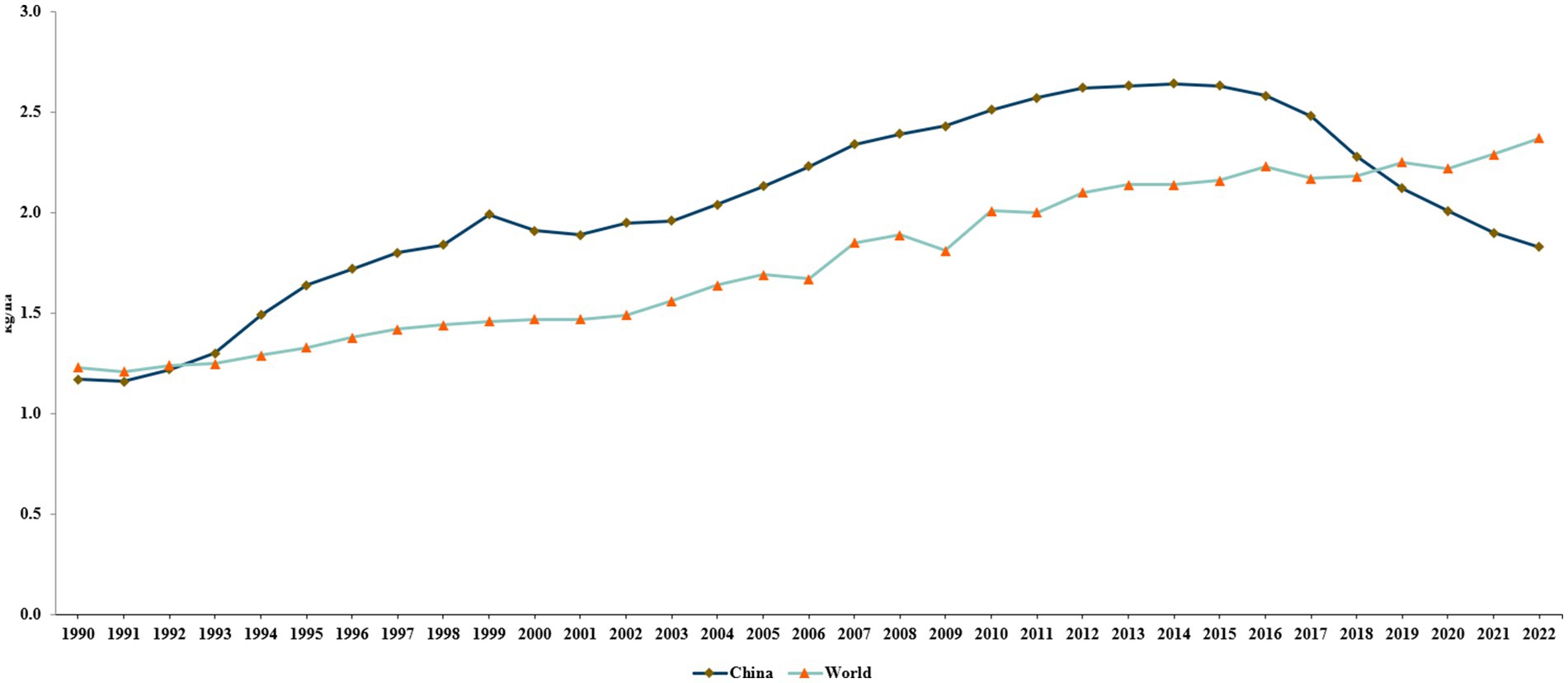
Figure 1. Pesticide use per area of cropland for the world and China (1990–2022). Data source: FAOSTAT.
Why has the promotion of GCT in China, also a developing country, been relatively successful? Many scholars argue that the lack of technical information is a major barrier to the adoption of new technologies by farmers in developing countries (Murage et al., 2015). Therefore, it is hypothesized that in addition to necessary policy support, China’s effective technology promotion may also benefit from its strategy of building digital villages. Statistical data indicate that the digitalization process in rural areas of China is accelerating, as shown in Figure 2. On one hand, digital information infrastructure has been continuously optimized and upgraded, with 100% of villages now connected to broadband, and more than 99% of villages having access to fiber-optic and 4G networks (Ministry of Agriculture and Rural Affairs of the People's Republic of China (MOA), 2023). On the other hand, farmers’ ability to utilize digital technology (DT) has rapidly improved, with rural Internet penetration reaching 63.8%, an approximately eightfold increase since the early 21st century (China Internet Network Information Center (CNNIC), 2024). As an “information highway,” DT not only transforms traditional lifestyles but also gradually permeates agricultural production, introducing various agricultural service models such as farmer assistance hotlines and agricultural science education cloud platforms. This breakthrough has moved agricultural technology services from the fields to online platforms, disrupting the traditional hierarchical structure of information transmission and significantly reducing constraints on farmers’ access to technical information. It is conducive to the promotion and application of GCT among farmers. According to monitoring data, the informatization rate of agricultural technology extension services in China has reached 61.3% (Ministry of Agriculture and Rural Affairs of the People's Republic of China (MOA), 2023).
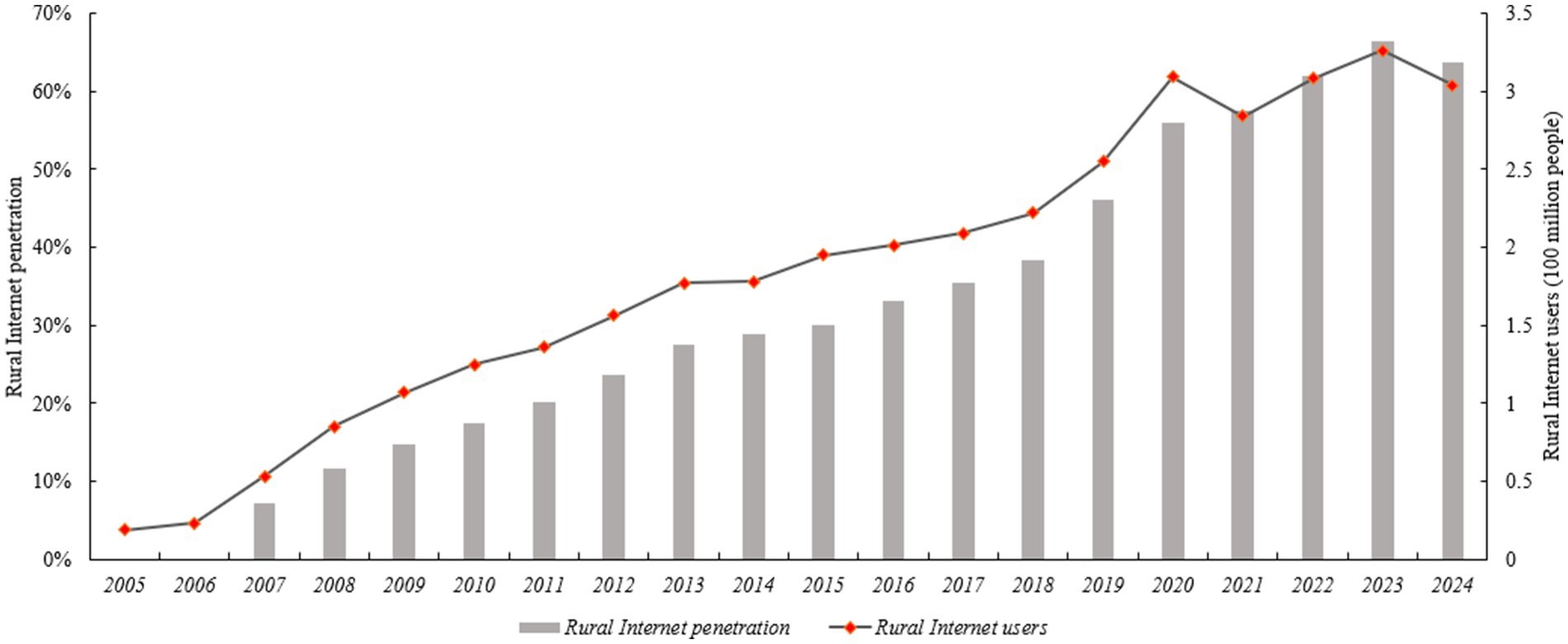
Figure 2. Scale of rural internet users and internet penetration rate in China (2005–2024). Source: CNNIC.
Despite the growing interest in GCT, research on the influence of DT on GCT adoption remains limited. Existing studies primarily focus on the decision incentives and influencing factors related to agricultural green technologies. Initial research on adoption incentives was centered on farmers’ profit-maximization objectives (Buurma and Van Der Velden, 2017; Feder and Slade, 1984). This focus later shifted to comparing the marginal benefits and costs of adopting new technologies (Atanu et al., 1994), ultimately evolving into a rational assessment of whether the benefits of adopting new technologies exceed those of existing ones (Kong et al., 2004). A series of studies on influencing factors suggests that demographic characteristics (Zegeye et al., 2022), income (Huang X. et al., 2022), land scale (Allahyari et al., 2016; Wu et al., 2018), market environment (Chappell et al., 2019), and policy conditions (Shi et al., 2024) all impact farmers’ decision-making. However, consensus on these factors remains elusive. Even the few studies that consider the impact of DT, have primarily focused on new crop varieties (Huang Z. et al., 2022), soil fertilization techniques (Chen X. et al., 2023), or broadly on overall green production technologies (Cai et al., 2022). Most of these studies have consistently praised the outstanding role of DT in the dissemination of these technologies. However, unlike the aforementioned technologies, GCT involves higher technical requirements and more uncertain outcomes (Seufert et al., 2012). This leads to the situation where DT, while facilitating the dissemination of information on GCT, also exposes farmers to potential yield reduction risks due to improper technical operations (Handel and Schwartzstein, 2018). The uncertainty of technology adoption risks undoubtedly hinders farmers’ willingness and behavior to adopt GTC. Thus, does the use of DT also promote the adoption of GCT? If so, how does it facilitate adoption? These issues still require further in-depth discussion.
To address this gap, the study utilizes micro-survey data from Chinese farmers and employs the Control Function (CF) approach, and Propensity Score Matching (PSM) method to examine the association between farmers’ use of DT and their adoption of GCT. It further examines the role of technological perception in the process and compares the effect differences across groups of farmers with varying endowments. The study offers two main marginal contributions. First, this study examines farmers’ adoption behavior of GCT from the perspective of DT, in the context of the global digitalization wave, and reaches robust conclusions through endogenous treatment models. This provides new insights into addressing the challenges of promoting GCT in developing countries. Second, by extending the Technology Acceptance Model (TAM), the study separately analyzes the mediation mechanisms of perceived usefulness (PU), perceived ease of use (PEU), and perceived risk (PR) in technology adoption, and it assesses the heterogeneity of these effects, helping to refine policy measures.
2 Theoretical analysis
The adoption of any technology is fundamentally based on information acquisition (Gonzaga et al., 2019). In traditional Chinese rural areas, however, farmers operate within a social network bound by kinship and geography, characterized by an evident hierarchical pattern of information transmission (Fei et al., 1992), resulting in relatively limited access to information (Zhang et al., 2024). The advent of DT has sparked a new wave of information explosion, progressively reshaping various aspects of rural development (Liu et al., 2024). In the dissemination of agricultural technology, DT not only breaks down the information transmission hierarchy with its capacity for transcending time and space, enhancing the efficiency of technology information dissemination (Aker, 2011; Norton and Alwang, 2020), but also connects technology demand and supply through online platforms, reducing obstacles to in one-way information flow (Shen et al., 2022). Furthermore, by utilizing mega data, farmers can receive targeted and continuous information push services, which facilitate a shift in their mindset and behaviors (Pan et al., 2017).
Upon receiving information, farmers may further internalize it, forming subjective judgments that lead to adoption decisions. That is, the Theory of Planned Behavior and the TAM advocate that, farmers’ decision-making is influenced by their perception of the technology (Davis et al., 1989). Notably, PU and PEU are critical factors that significantly encourage farmers to adopt new technologies (Verma and Sinha, 2018).
PU indicates farmers’ psychological recognition of the benefits associated with adopting GCT (Davis et al., 1989). The adoption of GCT offers economic, social, and ecological benefits (Rahman et al., 2018), yet farmers often find it challenging to evaluate these values and advantages (Wyckhuys et al., 2018). DT can assist farmers by visualizing the benefits of GCT, clarifying subsidy policies, and promoting green consumption concepts, aiding farmers in optimizing resource allocation (Xu et al., 2024). Throughout this process, digital information enhances farmers’ positive expectations of GCT, providing the initial drive for its adoption.
PEU refers to farmers’ psychological perception of the ease with which they can master new technologies (Sørebø and Eikebrokk, 2008; Taylor and Todd, 1995). Generally, adopting GCT requires farmers to invest time, effort, and money to relearn and adapt. If farmers find this process manageable, the cost of adoption is relatively low. Unlike traditional one-way technology delivery, DT enables farmers to shift from passive to active learning of technology. Without having to wait, farmers can access the application steps, operational tools, and maintenance methods of GCT anytime and anywhere. They can also use information sharing to seek solutions promptly when encountering technical difficulties. This means that the physical and time costs of learning the technology are greatly reduced (Kusi-Sarpong et al., 2022), encouraging more farmers to adopt GCT.
In reality, GCT is a knowledge-intensive and risk-and-return technology (Seufert et al., 2012), characterized by a high technical threshold and market risk. Therefore, on digital platforms flooded with diverse information, farmers inevitably encounter negative comments or failure cases related to GCT while seeking information (Lamichhane et al., 2018), leading to PR, which represents an expectation of potential losses when adopting new technologies. Minimizing risks to ensure household consumption has long been a critical goal for farmers (Scott, 1977). In the initial phase of GCT adoption, improper operations might cause yield reductions, and subsequent challenges such as the “lemon market” could hinder the monetization of green products. These risks run counter to farmers’ production goals and may deepen their skepticism toward GCT. Particularly for farmers with weak information discrimination abilities and risk aversion, even unfounded negative information may prompt them to imitate non-adoption behavior (Ali et al., 2023).
Overall, DT use is more likely to be associated with positive rather than negative outcomes in promoting GCT. While DT may introduce some negative information during the dissemination process, its broad reach aids in increasing awareness and acceptance of the technology, and it provides timely and effective positive guidance through online platforms. Therefore, from a long-term and comprehensive perspective, the DT can enhance farmers to insight into the benefits and potential costs of GCT, helping them to be more decisive and proactive in mastering GCT (Chen H. et al., 2023). The theoretical analysis framework of this study is shown in Figure 3. The research hypotheses are as follows:
H1: DT generally facilitates farmers' adoption of GCT.
H2: DT enhances farmers' PU, thereby promoting their adoption of GCT.
H3: DT enhances farmers' PEU, thereby promoting their adoption of GCT.
H4: DT increases farmers' PR, thereby hindering their adoption of GCT.
3 Methodology
3.1 Data
The research team conducted field interviews with rice farmers in Sichuan Province, China, from July to September 2023. The selection of research subjects was primarily based on the following considerations: First, rice is one of the staple foods in many countries across Asia, Africa, and Latin America, occupying a vital position in the global food supply chain. Rice pests and diseases are diverse, with over 20 types of pests causing economic losses, leading to an average yield reduction of approximately 20% (Pathak and Khan, 1994). As a result, the use of traditional chemical pesticides in rice cultivation is significant, making the promotion of GCT an urgent priority. Second, China ranks second in rice cultivation area and first in rice production globally, Sichuan Province accounts for 6.27% of China’s rice cultivation area and 7.02% of the annual production (National Bureau of Statistics of China (NBSC), 2023). Therefore, Sichuan is one of China’s major rice-producing provinces, and its rice cultivation practices are representative.
The study first employed a random sampling method to select five sample cities: Chengdu, Mianyang, Guangan, Luzhou, and Yibin. Subsequently, using administrative stratification and stratified random sampling techniques, 1–3 sample counties were randomly selected within each sample city. Similarly, 1–3 sample towns were randomly selected within each sample county, followed by 1–3 sample villages in each sample town. Finally, in each sample village, 15–25 rice-growing households were randomly selected as respondents for insightful interviews. The content included member characteristics, agricultural production, technology adoption, and consumption expenditures. After excluding invalid responses, the study obtained a total of 608 valid questionnaires. The sample distribution is illustrated in Figure 4.
3.2 Variables
The dependent variable is the adoption behavior of rice farmers toward GCT. In practical application, based on the characteristics of rice production and field survey results, the study focuses on three types of GCTs: biopesticides, natural enemy control, and physical control. These technologies differ in terms of acquisition and operational complexity, implementation costs, and information requirements. For example, natural enemy-based control often demands higher levels of technical knowledge from farmers; biopesticide application requires accurate identification of pest species and appropriate chemical matching; while physical control, though more intuitive, still necessitates understanding of pest life cycles and trapping timing. Regardless of the technology chosen, farmers must access relevant pest information and technical guidance, highlighting their reliance on the information environment. Given that each of these technologies can effectively serve the purpose of pest control, this study emphasizes whether a farmer adopts any of the GCT. Accordingly, a binary indicator is constructed: if a farmer adopts at least one of the three, the variable is coded as 1; otherwise, it is coded as 0.
The use of DT serves as the key independent variable. While smartphones, computers, and other smart devices have become common in rural areas, the effectiveness of DT relies not only on device connectivity but also on farmers’ ability to use these devices to search, access, and analyze agricultural data resources. Building on the approaches of Kai et al. (2023), this study represents the key independent variable as “whether farmers use DT, such as mobile phones or computers, to access agricultural information.” Additionally, to comprehensively measure DT use, the study integrates various aspects of farmers’ production and daily life, including social interaction, information acquisition, input purchase, and product sales. During the survey, farmers are asked to rate the extent of their DT use in these aspects on a five Likert scale. Subsequently, the entropy weight method was applied to assign weights to the indicators based on the amount of information each conveys, and an aggregated index was constructed as an alternative measure of DT use for robustness checks. Compared with simple averaging, the entropy method captures the heterogeneity across indicators more effectively by assigning greater weight to those with higher information variability, thereby enhancing the representativeness and objectivity of the composite index. Therefore, this study adopts the entropy weighting approach for indicator aggregation.
There may be endogeneity issues between GCT adoption and DT use, potentially due to reverse causality or omitted variables. To address this, this study follows the approach of Luo and Liu (2022), selecting household internet access cost as the instrumental variable for DT use. This variable reflects the cost incurred by farmers in accessing digital information and is theoretically expected to be significantly associated with their DT use. However, we also acknowledge that higher household internet expenditure may correlate with stronger economic capacity, which in itself could facilitate the adoption of GCT. To mitigate this potential confounding pathway, the model controls for key variables indicative of household economic capacity, including the household head’s education and occupation, household size, number of laborers, and cultivated land area. Given that these covariates account for the majority of economic differences across households, the effect of internet expenditure on GCT adoption—after controlling for these factors—can be reasonably attributed to its influence through DT use. This ensures the validity of the exclusion restriction in the context of our study. In summary, “household expenditure on communication and internet services” satisfies both the relevance and exclusion criteria, and thus serves as a valid instrumental variable for the core explanatory variable in this research framework.
Technical perception serves as the mediator. Based on theoretical analysis, technical perception is divided into three aspects: PU, PEU, and PR. Drawing on Huang X. et al. (2022), the study further classifies perceived benefits into economic, social, and ecological dimensions. Economic benefits perception is measured through questions such as: “To what extent do you believe green production technologies increase income?,” “enhance yields?,” “reduce material input costs?,” and “save labor?.” Social benefits perception is assessed using statements like: “Adopting green production technologies improves food safety,” “benefits other members of society,” and “contributes to social development.” Ecological benefits are gauged via: “How effective do you perceive green production technologies to be in environmental protection?,” “in conserving natural resources?,” and “in reducing environmental pollution?” Perceived ease of use is measured by the respondent’s level of agreement with the statement: “GCT are easy to master.” PR is assessed by asking whether they perceive GCTs as carrying minimal technical risk (e.g., yield reduction) and market risk (e.g., failure to achieve premium pricing). All items are rated using five-point Likert scales. For multi-item constructs, the entropy weight method is applied to compute composite indices, which assigns greater weights to variables with higher informational variance, thus improving the indicators’ representativeness and objectivity.
Farmers’ decisions to adopt technology are influenced by multiple factors. Therefore, individual, household, and environmental characteristics are incorporated as control variables (Creissen et al., 2021; Wu et al., 2018). Additionally, to account for the potential influence of location, terrain, and unobserved regional factors, the study includes variables such as distance to the nearest county, topography, and locational dummy variables. Variable descriptions are provided in Table 1.
3.3 Characteristics of data
The t-test results further visually illustrate the characteristic differences between rice farmers who use DT and those who do not. Specifically, 72.3% of DT-using rice farmers have adopted GCT, while only 24.8% of non-DT-using farmers have done so, with the difference being significantly positive at the 1% level. It can be intuitively inferred that DT users generally perform better in implementing GCT. Additionally, the internet access cost, as the cost of DT use, is understandably higher among DT users compared to non-users. In terms of technical perception, DT users exhibit stronger PU, PEU, and PR regarding the technology than non-users, indicating greater confidence in the benefits and operability of GCT, along with a lower estimate of its risks. Furthermore, DT users are usually to be younger, more educated, risk-tolerant, engaged in larger-scale farming, located closer to the county, and residing in flatter terrains.
3.4 Models
Firstly, the study aims to clarify the direct and overall associations between DT use and the adoption of GCT. Given that farmers’ decisions regarding the adoption of GCT are binary, a Probit model is employed for the foundational analysis, structured as follows:
In Equation 1, represents the adoption decision of GCT by rice farmer i, and denotes the DT use of rice farmer i, encompassing both the decision to use DT and the capacity to utilize it; includes the individual, household, and environmental control variables of rice farmers; is the constant term; are the coefficients to be estimated, and ε is the random error term.
Despite incorporating numerous control variables in Equation 1, potential omissions remain inevitable, leading to endogeneity. To address it, the study continues to employ the CF approach for estimation. This approach is advantageous due to its flexibility and ability to intuitively identify endogeneity within the results (Wooldridge, 2015). The process involves two main steps: first, DT use is treated as the dependent variable, with the instrumental variable incorporated as key independent variable to estimate the generalized residual, as shown in Equation 2; second, the generalized residual is then included in Equation 1 for re-estimation, as demonstrated in Equation 3. If the residual is significant, it indicates that DT is an endogenous explanatory variable, and including the residual corrects estimation bias. If the residual is not significant, it suggests that DT is not an endogenous explanatory variable, making the regression results without the residual more valid and unbiased. Based on this approach, the following model is constructed:
In Equations 2, 3, represents household internet access cost for farmer i, is the generalized residual obtained from Equation 2, and are constants, , and , are the coefficients to be estimated, ϵ and θ are random disturbance terms.
Equation 1 may also be subject to endogeneity arising from “self-selection,” as both the adoption of DT and GCT by farmers may be influenced by some same factors (Gao et al., 2020; Zheng et al., 2022). To address this, the study applies the PSM method within the “counterfactual” framework to verify the relationship between DT use and GCT adoption. The main modeling ideas are as follows: First, a regression model estimates each farmer’s probability of DT use, yielding a propensity score for each sample. Second, all sample farmers are categorized into a treatment group (users) and a control group (non-users) based on DT use, and different matching methods are employed to pair samples with similar propensity scores across both groups. Third, the difference in GCT adoption rates between the two groups is analyzed to determine the average treatment effect on the treated (ATT). The final expression is as follows:
In Equation 4, indicates whether farmer i belongs to the treatment group, for using DT, for not adopting DT; represents the propensity score, and denote the outcomes for the treatment and control groups, respectively.
After clarifying the direct effects, the study also investigates the mechanisms based on Equation 1. The testing method follows the stepwise regression equation method proposed by Baron and Kenny (1986), constructing the mediation model as follows:
In Equations 5–7, is the mediator, which indicates rice farmers’ perception of GCT, encompassing PU, PRU, and PR. and are constants, are coefficients to be estimated, π and τ represent random disturbance terms.
4 Results and discussion
4.1 Baseline regression and robustness test
Table 2 presents the results of the basic regression analysis. Model (1)–Model (4) employs stepwise regression by gradually adding control variables. It is clear that, there is still a positive correlation on the 1% statistical criterion between the adoption behavior of GCT and the use behavior of DT among rice farmers, even after including more restrictive factors.
Moreover, to ensure robustness, Model (5) conducts a re-test by replacing the key independent variable. The robustness check results are consistent with the stepwise regression findings, indicating that the positive association between DT use and GCT adoption remains highly significant.
4.2 Endogeneity treatment
This study further employs the CF approach and the PSM method for correction. Model (1), the first stage of the CF approach, results indicate a positive correlation between household internet access cost and the use of DT, demonstrating that internet access cost meet the relevance criterion as instrumental variable. Subsequently, in Model (2), the results of the following stage, the residual is significantly positive, confirming the endogeneity of DT use. This suggests that estimating with a standard Probit model alone would lead to an overestimation of DT’s effect, whereas including the residual corrects for estimation bias. Specifically, compared to the baseline regression, the coefficient of DT use derived from the CF approach is lower. However, the association between DT use and the adoption of GCT remains positive and statistically significant at the 1% level. The average marginal effect further clarifies the economic implications of the data: when rice farmers choose to DT, the probability of them adopting GCT will go up approximately 16.1% on average. The specific analysis results are shown in Table 3.
Based on different matching methods, PSM method may yield varying results. To enhance the reliability of the conclusions, this study conducts tests using nearest neighbor matching (1:1), radius matching, and kernel matching. As shown in Table 4, the ATT calculated by all the methods are very similar, and all of them are very positive and significant (due to space constraints, the estimation results of the propensity scores are omitted here). Specifically, the likelihood of rice farmers adopting GCT increased to approximately 68% among those using DT, which is significantly higher by about 26.3% compared to those not using DT.
In summary, after addressing endogeneity, DT use has been confirmed to have value in promoting technological adoption. This finding differs from the studies by Zhou et al. (2023), as well as Yu and Zhang (2009), both of which did not identify a correlation between internet use and IPM application. In the former, the key independent variable was measured directly as “whether or not the internet was used,” which failed to eliminate interference from non-productive uses, potentially obscuring the correlation. The differences with the latter study stem from the historical context. This study is conducted against the backdrop of rapid DT development in rural China. The conclusions are indirectly supported by Cai et al. (2022), as well as Gao et al. (2020), who similarly affirm the necessity of using DT to facilitate the penetration of GCT.
Murage et al. (2015) have pointed out that successfully transmitting information to target recipients is a prerequisite for technology adoption. DT has further expanded farmers’ access to information beyond traditional agricultural technology dissemination models (Barnett et al., 2019). In terms of information scope, digital information technology reduces information search costs and fosters the creation and broad sharing of technical information (Shen et al., 2022; Wu and Zhang, 2020). Meanwhile, given the multi-period characteristics of GCT, farmers face a heightened need for intensive and sustained access to information (Lou et al., 2021). Unlike occasional promotional training, DT continuously accompanies farmers, subtly shaping their green production mindset (Pan et al., 2017).
4.3 Mediation mechanisms
Based on the extended TAM, this study employs the B-K stepwise regression equation to examine the mediation effects of PU, PEU, and PR in the relationship between DT use and GCT adoption. This analysis is complemented by the Bootstrap and Sobel tests (Wen and Ye, 2014). The specific analysis results are shown in Table 5.
The B-K stepwise regression equation results show that the use of DT significantly enhances rice farmers’ PU, PEU, and PR associated with GCT. After controlling for the direct effects of DT use, these three perceptions further exhibit a clear positive impact on the GCT adoption. The 95% confidence interval of the mediation effects obtained through the Bootstrap test also did not include zero. These data indicate that DT use raises farmers’ expectations regarding the benefits and convenience of GCT while simultaneously reducing their risk assessments, ultimately promoting GCT adoption. H2 and H3 are confirmed, while H4 is rejected.
This finding aligns with the rational smallholder hypothesis and supports the theory put forward by Nowak (1987), which emphasizes that making the target group aware of the necessity of the technology and providing adaptation assistance are prerequisites for technology diffusion. Generally, studies suggest that the most valuable, low-risk innovations are often the quickest to be adopted (Fliegel and Kivlin, 1966). In practice, mastering the essentials of GCT can enhance farmers’ welfare. As a robust information channel, DT can improve farmers’ operational capabilities and promote the realization of technical benefits, providing intrinsic motivation for technology adoption (Samiee et al., 2009; Verma and Sinha, 2018). Risk, meanwhile, implies uncertainty and threat (Trujillo-Barrera et al., 2016). Although theoretically, digital media might expose cases of DT failure, potentially leading farmers to overestimate risks, the opposite has proven true: DT effectively lowers PR and fosters technology adoption. This can be attributed to two factors. First, DT helps to bridge the information asymmetry in the market and enhance individual development capabilities (Zheng and Lu, 2021), thus reducing uncertainty in the technology adoption process (Luh et al., 2014). Second, DT’s visibility and traceability render GCT’s operational steps more transparent and simplified, instilling confidence in farmers about their capacity to use GCT effectively, thereby lowering their PR of adoption. Rather than leaving farmers in a technological “black box,” transparency of technical information helps mitigate the fear associated with unknown risks. Moreover, distinguishing between different sources of digital information may yield varying conclusions. For instance, guidance from research institutions or government extension platforms may reduce farmers’ risk perception, whereas peer exchanges on social media might amplify it by emphasizing negative experiences. Unfortunately, this study does not differentiate farmers’ digital information sources in detail, which represents a promising direction for future research.
In comparing the mediation effects of the three types of cognition, the study also reveals that PU, PEU, and PR account for 45.05, 35.13, and 17.09% of the mediation effect, respectively, showing a decreasing trend. This finding reflects the underlying logic that benefit drives technology dissemination, suggesting that amid growing support and technological maturity, digital media in China places significant emphasis on promoting the benefits of GCT, laying a strong foundation for its adoption.
4.4 Heterogeneity analysis
The breadth and depth of information acquisition using DT vary among farmers, leading to different behavioral responses, due to the gap of farmers’ resources endowments. To capture this variability, the study selects age and area of rice cultivation, and the distance from the housing to the county, corresponding to individual, household, and environmental characteristics, respectively, for group discussions. Notably, to alleviate endogeneity interference, the study continues to use the CF approach for estimation. The research results are shown in Figures 5–7.
The comparative results among different age groups indicate that the use of DT is significantly associated with the adoption of GCT among younger farmers, whereas no significant association is observed among older farmers. Two potential reasons for this finding are: first, due to differences in education levels and technological acceptance, older farmers may not be as proficient in using digital tools like the internet as their younger counterparts, which limits the effectiveness of DT (Chen H. et al., 2023); second, older farmers typically rely on their past planting experiences and traditional methods, leading them to be skeptical of the information obtained through DT, they may be reluctant to alter their established planting habits in the short term (Murage et al., 2015).
The comparative results across groups with varying rice cultivation areas indicate that the use of DT positively influences the adoption of GCT across all scales of rice farming. However, this association is more pronounced among farmers with smaller landholdings. Gao et al. (2020) reached similar conclusions, attributing this effect to the greater capacity increment benefits brought by the adoption of DT for smallholders. However, the study suggests two additional reasons. From a technological demand perspective, smaller-area farmers primarily grow rice for self-consumption, making them more likely to accept GCT to ensure food safety (Yu and Zhang, 2009). Although large-scale farmers possess capital and scale advantages conducive to adopting GCT, their rice production is primarily market-oriented. Under China’s underdeveloped green agricultural product market, it is difficult for green products to command price premiums. Therefore, aiming to maximize benefits and minimize risks, large-scale farmers are more likely to rely on chemically stable pesticides. Regarding behavioral response speed, the decision-making processes of larger-area farmers are often more complex, whereas smaller-area farmers, have shorter decision chains, allowing for more flexibility in adjusting their production methods (Timprasert et al., 2014).
A comparison between closer-distance and farther-distance farmers indicates that the advantage of DT in enhancing the adoption of GCT is significant only among closer-distance farmers, while it is not significant among farther-distance farmers. This result may be due to differences in infrastructure arising from geographical location. Areas near the county usually have more agricultural extension agencies, technical service stations, and tool sales points, providing farmers with face-to-face technical guidance and necessary equipment support. In contrast, remote areas tend to have fewer relevant institutions, limiting farmers’ access to modern agricultural production technologies or equipment (Bello-Bravo et al., 2022).
5 Conclusion and policy implications
DT has not only transformed lifestyles but also emerged as a potential pathway for achieving ecological sustainability in rural areas. This study explores the relationship between DT use and rice farmers’ adoption of GCT from a micro-level perspective. It further analyzes the mediation effects of technology perceptions, based on an extended TAM. Finally, it examines the heterogeneity of this association across farmer groups differentiated by age, farm size, and residential proximity to urban centers. The study draws the following conclusions. (1) The use of DT significantly facilitates farmers’ adoption of GCT, and this result remains robust after addressing endogeneity; (2) Farmers’ perceptions of technology serve as mediators, including PU, PEU, and PR, with diminishing mediation effects in this order; (3) Younger farmers, those with smaller rice cultivation area, and those living closer to county benefit more from the advantages of DT. In this regard, the study puts forward several policy implications.
First, enhance farmers’ capacity to utilize DT. China’s digital infrastructure is robust, however, the utility of DT in agricultural production remains limited. Therefore, improving farmers’ proficiency in using DT should be a focal point of future policies. To address this, technology companies should establish more digital support platforms specifically tailored for farmers. For instance, developing user-friendly digital platforms or applications that offer one-stop digital services, to enhance the supply capacity of agricultural DT. The government and agricultural departments should leverage digital demonstration sites and local technical service stations to showcase the advantages of DT to a broader audience of farmers through methods such as on-site observation and experiential learning. This approach will stimulate farmers’ demand for DT and assist them in understanding and mastering fundamental DT operations.
Second, strengthen the authoritative dissemination of information and scientific outreach. Initially, government and research institutions should fully utilize the internet and new media platforms to disseminate authoritative information about GCT, including its advantages, successful cases, specific implementation steps, and risk mitigation measures. Promoting this information through official channels can help reduce the spread of rumors and misleading information. In the medium term, to address the risk of exaggerated claims about GCT circulating on the internet, relevant government departments can establish public opinion monitoring mechanisms to promptly identify issues and invite experts to provide online clarification, offering farmers concrete risk management strategies. In the long term, the government or enterprises may introduce agricultural insurance or establish corresponding risk mitigation mechanisms to help farmers share the economic losses that may arise from adopting new technologies.
Third, focus on vulnerable groups in information access and provide personalized services and guidance. For young farmers, the promotion of emerging technologies such as smartphone applications and agricultural IoT should be prioritized. In contrast, for older or less educated farmers, simplified equipment or applications should be developed, accompanied by “one-on-one” technical guidance. For small-area farmers, green and healthy agricultural solutions are preferred, while for large-area farmers, considerations should include the practicality, labor efficiency, and risk levels of the technology. Additionally, for farmers in remote areas, it is essential to not only provide necessary digital infrastructure but also to develop offline services that enable them to conveniently access tools and equipment. In addition, efforts should be made to cultivate local “digital technology demonstration households” to promote peer learning and the diffusion of innovative practices among neighboring farmers.
Data availability statement
The original contributions presented in the study are included in the article/supplementary material, further inquiries can be directed to the corresponding author.
Author contributions
XY: Conceptualization, Writing – original draft. JW: Writing – review & editing. WL: Writing – review & editing, Writing – original draft. JS: Methodology, Writing – review & editing.
Funding
The author(s) declare that financial support was received for the research and/or publication of this article. This study was funded by the Youth Project of National Social Science Fund of China (24CJY095), the Youth Project of Sichuan Rural Development Research Center Fund Project (CR2417), and China University Students’ Innovation and Entrepreneurship Training Program Project.
Acknowledgments
The authors extend their gratitude to the creators of the referenced works, the editorial team and the reviewers for their insightful comments and suggestions.
Conflict of interest
The authors declare that the research was conducted in the absence of any commercial or financial relationships that could be construed as a potential conflict of interest.
Generative AI statement
The authors declare that no Gen AI was used in the creation of this manuscript.
Any alternative text (alt text) provided alongside figures in this article has been generated by Frontiers with the support of artificial intelligence and reasonable efforts have been made to ensure accuracy, including review by the authors wherever possible. If you identify any issues, please contact us.
Publisher’s note
All claims expressed in this article are solely those of the authors and do not necessarily represent those of their affiliated organizations, or those of the publisher, the editors and the reviewers. Any product that may be evaluated in this article, or claim that may be made by its manufacturer, is not guaranteed or endorsed by the publisher.
References
Abdollahzadeh, G., Sharifzadeh, M. S., and Damalas, C. A. (2015). Perceptions of the beneficial and harmful effects of pesticides among Iranian rice farmers influence the adoption of biological control. Crop Prot. 75, 124–131. doi: 10.1016/j.cropro.2015.05.018
Aker, J. C. (2011). Dial “A” for agriculture: a review of information and communication technologies for agricultural extension in developing countries. Agric. Econ. 42, 631–647. doi: 10.1111/j.1574-0862.2011.00545.x
Ali, M., Gomes, L. M., Azab, N., de Moraes Souza, J. G., Sorour, M. K., and Kimura, H. (2023). Panic buying and fake news in urban vs. rural England: a case study of twitter during COVID-19. Technol. Forecast. Soc. Change 193:122598. doi: 10.1016/j.techfore.2023.122598
Allahyari, M. S., Damalas, C. A., and Ebadattalab, M. (2016). Determinants of integrated pest management adoption for olive fruit fly (Bactrocera oleae) in Roudbar, Iran. Crop Prot. 84, 113–120. doi: 10.1016/j.cropro.2016.03.002
Atanu, S., Love, H. A., and Schwart, R. (1994). Adoption of emerging technologies under output uncertainty. Am. J. Agric. Econ. 76, 836–846. doi: 10.2307/1243745
Barnett, W. A., Hu, M., and Wang, X. (2019). Does the utilization of information communication technology promote entrepreneurship: evidence from rural China. Technol. Forecast. Soc. Change 141, 12–21. doi: 10.1016/j.techfore.2019.01.007
Baron, R. M., and Kenny, D. A. (1986). The moderator–mediator variable distinction in social psychological research: conceptual, strategic, and statistical considerations. J. Pers. Soc. Psychol. 51, 1173–1182. doi: 10.1037/0022-3514.51.6.1173
Bello-Bravo, J., Medendorp, J., Lutomia, A. N., Reeves, N. P., Tamò, M., and Pittendrigh, B. (2022). Dramatically increased accessibility and decreased cost-per-person impacts are needed for scaling IPM in Africa. Curr. Opin. Insect Sci. 54:100971. doi: 10.1016/j.cois.2022.100971
Boedeker, W., Watts, M., Clausing, P., and Marquez, E. (2020). The global distribution of acute unintentional pesticide poisoning: estimations based on a systematic review. BMC Public Health 20, 1–19. doi: 10.1186/s12889-024-20318-x
Buurma, J., and Van Der Velden, N. (2017). New approach to integrated pest management research with and for horticulture. A vision from and beyond economics. Crop Prot. 97, 94–100. doi: 10.1016/j.cropro.2016.11.013
Cai, Y., Qi, W., and Yi, F. (2022). Mobile internet adoption and technology adoption extensity: evidence from litchi growers in southern China. China Agric. Econ. Rev. 14, 106–121. doi: 10.1108/CAER-11-2020-0260
Chappell, T. M., Magarey, R. D., Kurtz, R. W., Trexler, C. M., Pallipparambil, G. R., and Hain, E. F. (2019). Perspective: service-based business models to incentivize the efficient use of pesticides in crop protection. Pest Manag. Sci. 75, 2865–2872. doi: 10.1002/ps.5523
Chen, H., Li, P., and Li, Q. (2023). The impact of science and technology services on agricultural income of rural household: an investigation based on the three northeastern provinces of China. Technol. Forecast. Soc. Change 191:122542. doi: 10.1016/j.techfore.2023.122542
Chen, X., Xing, L., Wang, K., Zhang, Y., and Han, X. (2023). Nonlinear effects of internet development on chemical fertilizer application intensity: macro evidence from China. J. Clean. Prod. 386:135794. doi: 10.1016/j.jclepro.2022.135794
China Agricultural Green Development Research Society (2023). China agricultural green development report 2022. (in Chinese).
China Internet Network Information Center (CNNIC). (2024). Statistical report on internet development in China. (in Chinese)
Creissen, H. E., Jones, P. J., Tranter, R. B., Girling, R. D., Jess, S., Burnett, F. J., et al. (2021). Identifying the drivers and constraints to adoption of IPM among arable farmers in the UK and Ireland. Pest Manag. Sci. 77, 4148–4158. doi: 10.1002/ps.6452
Davis, F. D., Bagozzi, R. P., and Warshaw, P. R. (1989). User acceptance of computer technology: a comparison of two theoretical models. Manag. Sci. 35, 982–1003. doi: 10.1287/mnsc.35.8.982
Elahi, E., Weijun, C., Zhang, H., and Abid, M. (2019). Use of artificial neural networks to rescue agrochemical-based health hazards: a resource optimisation method for cleaner crop production. J. Clean. Prod. 238:117900. doi: 10.1016/j.jclepro.2019.117900
Farah, I. F., dos Santos, C. R., Pinto, M. C. F., Araújo, C. R., and Amaral, M. C. S. (2024). Pesticides in aquatic environment: Occurrence, ecological implications and legal framework. J. Environ. Chem. Eng. 114072. doi: 10.1016/j.jece.2024.114072
Feder, G., and Slade, R. (1984). The acquisition of information and the adoption of new technology. Am. J. Agric. Econ. 66, 312–320. doi: 10.2307/1240798
Fei, X., Hamilton, G. G., and Zheng, W. (1992). From the soil: the foundations of Chinese society : Univ of California Press.
Fliegel, F. C., and Kivlin, J. E. (1966). Attributes of innovations as factors in diffusion. Am. J. Sociol. 72, 235–248. doi: 10.1086/224292
Food and Agriculture Organization of the United Nations (FAO). (2024). FAOSTAT- pesticides use. Available online at: https://www.fao.org/faostat/en/#data/RP (Accessed October 10, 2024).
Gao, Y., Niu, Z., Yang, H., and Yu, L. (2019). Impact of green control techniques on family farms welfare. Ecol. Econ. 161, 91–99. doi: 10.1016/j.ecolecon.2019.03.015
Gao, Y., Zhao, D., Yu, L., and Yang, H. (2020). Influence of a new agricultural technology extension mode on farmers' technology adoption behavior in China. J. Rural. Stud. 76, 173–183. doi: 10.1016/j.jrurstud.2020.04.016
Gonzaga, J. F., Vilpoux, O. F., and Pereira, M. W. G. (2019). Factors influencing technological practices in the Brazilian agrarian reform. Land Use Policy 80, 150–162. doi: 10.1016/j.landusepol.2018.10.005
Handel, B., and Schwartzstein, J. (2018). Frictions or mental gaps: what's behind the information we (don't) use and when do we care? J. Econ. Perspect. 32, 155–178. doi: 10.1257/jep.32.1.155
Huang, X., Yang, F., and Fahad, S. (2022). The impact of digital technology use on farmers’ low-carbon production behavior under the background of carbon emission peak and carbon neutrality goals. Front. Environ. Sci. 10:1002181. doi: 10.3389/fenvs.2022.1002181
Huang, Z., Zhuang, J., and Xiao, S. (2022). Impact of mobile internet application on farmers’ adoption and development of green technology. Sustainability 14:16745. doi: 10.3390/su142416745
Kai, L., Yu, J., and Zhou, J.-H. (2023). Are vulnerable farmers more easily influenced? Heterogeneous effects of internet use on the adoption of integrated pest management. J. Integr. Agric. 22, 3220–3233. doi: 10.1016/j.jia.2023.08.005
Kondo, E., Asem, F. E., Osei-Asare, Y., Mensah-Bonsu, A., Onumah, E. E., Ofori, S., et al. (2025). Economic and behavioural effects of farmers’ adoption of integrated pest management practices in low-and middle-income countries: a systematic review and meta-analysis. NJAS Impact Agric. Life Sci. 97:2534478. doi: 10.1080/27685241.2025.2534478
Kong, X., Fang, S., Pang, X., and Ma, J. (2004). Analysis of the effect of household endowments on the agricultural technology adoption decision in West China. Econ. Res. J. 12, 85–95+122. (in Chinese)
Kusi-Sarpong, S., Mubarik, M. S., Khan, S. A., Brown, S., and Mubarak, M. F. (2022). Intellectual capital, blockchain-driven supply chain and sustainable production: role of supply chain mapping. Technol. Forecast. Soc. Change 175:121331. doi: 10.1016/j.techfore.2021.121331
Lamichhane, J. R., Akbas, B., Andreasen, C. B., Arendse, W., Bluemel, S., Dachbrodt-Saaydeh, S., et al. (2018). A call for stakeholders to boost integrated pest management in Europe: a vision based on the three-year European research area network project. Int. J. Pest Manag. 64, 352–358. doi: 10.1080/09670874.2018.1435924
Liu, Y., Dai, Z., and Zhao, X. (2024). Unveiling the blueprint for rural digital prosperity: a comparative examination of top 100 digital counties in China. Technol. Forecast. Soc. Change 208:123625. doi: 10.1016/j.techfore.2024.123625
Lou, S., Zhang, B., and Zhang, D. (2021). Foresight from the hometown of green tea in China: tea farmers’ adoption of pro-green control technology for tea plant pests. J. Clean. Prod. 320:128817. doi: 10.1016/j.jclepro.2021.128817
Luh, Y. H., Jiang, W. J., and Chien, Y. N. (2014). Adoption of genetically-modified seeds in Taiwan: the role of information acquisition and knowledge accumulation. China Agric. Econ. Rev. 6, 669–697. doi: 10.1108/CAER-03-2013-0037
Luo, M., and Liu, Z. (2022). Digital technology adoption, social network expansion and farmers' common prosperity. South China J. Econ. 3, 1–16. (in Chinese)
Ministry of Agriculture and Rural Affairs of the People's Republic of China (MOA) (2023). China digital rural development report (2022). Beijing (in Chinese).
Murage, A., Midega, C., Pittchar, J., Pickett, J., and Khan, Z. (2015). Determinants of adoption of climate-smart push-pull technology for enhanced food security through integrated pest management in eastern Africa. Food Secur. 7, 709–724. doi: 10.1007/s12571-015-0454-9
National Bureau of Statistics of China (NBSC) (2023). China statistical yearbook. Beijing (in Chinese).
Norton, G. W., and Alwang, J. (2020). Changes in agricultural extension and implications for farmer adoption of new practices. Appl. Econ. Perspect. Policy 42, 8–20. doi: 10.1002/aepp.13008
Nowak, P. J. (1987). The adoption of agricultural conservation technologies: economic and diffusion explanations. Rural. Sociol. 52:208.
Pan, D., Kong, F., Zhang, N., and Ying, R. (2017). Knowledge training and the change of fertilizer use intensity: evidence from wheat farmers in China. J. Environ. Manag. 197, 130–139. doi: 10.1016/j.jenvman.2017.03.069
Qiao, D., Luo, L., Chen, C., Qiu, L., and Fu, X. (2023). How does social learning influence Chinese farmers’ safe pesticide use behavior? An analysis based on a moderated mediation effect. J. Clean. Prod. 430:139722. doi: 10.1016/j.jclepro.2023.139722
Rahman, M. S., Norton, G. W., and Rashid, M. H. A. (2018). Economic impacts of integrated pest management on vegetables production in Bangladesh. Crop Prot. 113, 6–14. doi: 10.1016/j.cropro.2018.07.004
Raj, A., Kumar, A., and Dames, J. F. (2021). Tapping the role of microbial biosurfactants in pesticide remediation: an eco-friendly approach for environmental sustainability. Front. Microbiol. 12:791723. doi: 10.3389/fmicb.2021.791723
Rezaei, R., Safa, L., Damalas, C. A., and Ganjkhanloo, M. M. (2019). Drivers of farmers’ intention to use integrated pest management: integrating theory of planned behavior and norm activation model. J. Environ. Manag. 236, 328–339. doi: 10.1016/j.jenvman.2019.01.097
Samiee, A., Rezvanfar, A., and Faham, E. (2009). Factors influencing the adoption of integrated pest management (IPM) by wheat growers in Varamin County, Iran. Afr. J. Agric. Res. 4, 491–497.
Scott, J. C. (1977). The moral economy of the peasant: rebellion and subsistence in Southeast Asia : Yale University Press.
Seufert, V., Ramankutty, N., and Foley, J. A. (2012). Comparing the yields of organic and conventional agriculture. Nature 485, 229–232. doi: 10.1038/nature11069
Shen, Z., Wang, S., Boussemart, J.-P., and Hao, Y. (2022). Digital transition and green growth in Chinese agriculture. Technol. Forecast. Soc. Change 181:121742. doi: 10.1016/j.techfore.2022.121742
Shi, L., Pang, T., Peng, H., and Feng, X. (2024). Green technology outsourcing for agricultural supply chains with government subsidies. J. Clean. Prod. 436:140674. doi: 10.1016/j.jclepro.2024.140674
Sørebø, Ø., and Eikebrokk, T. R. (2008). Explaining IS continuance in environments where usage is mandatory. Comput. Human Behav. 24, 2357–2371. doi: 10.1016/j.chb.2008.02.011
Stern, V., Smith, R., Van den Bosch, R., and Hagen, K. (1959). The integration of chemical and biological control of the spotted alfalfa aphid: the integrated control concept. Hilgardia 29, 81–101.
Tambo, J. A., Holmes, K. A., Aliamo, C., Mbugua, F., Alokit, C., Muzira, F., et al. (2024). The role of agro-input dealer certification in promoting sustainable pest control: insights from Uganda. Int. J. Agric. Sustain. 22:2299181. doi: 10.1080/14735903.2023.2299181
Taylor, S., and Todd, P. (1995). Assessing IT usage: the role of prior experience. MIS Q. 19, 561–570. doi: 10.2307/249633
Timprasert, S., Datta, A., and Ranamukhaarachchi, S. (2014). Factors determining adoption of integrated pest management by vegetable growers in Nakhon Ratchasima Province, Thailand. Crop Prot. 62, 32–39. doi: 10.1016/j.cropro.2014.04.008
Trujillo-Barrera, A., Pennings, J. M., and Hofenk, D. (2016). Understanding producers' motives for adopting sustainable practices: the role of expected rewards, risk perception and risk tolerance. Eur. Rev. Agric. Econ. 43, 359–382. doi: 10.1093/erae/jbv038
Verma, P., and Sinha, N. (2018). Integrating perceived economic wellbeing to technology acceptance model: the case of mobile based agricultural extension service. Technol. Forecast. Soc. Change 126, 207–216. doi: 10.1016/j.techfore.2017.08.013
Wen, Z., and Ye, B. (2014). Mediating effect analysis: methodology and model development. Adv. Psychol. Sci. 22, 731–745. (in Chinese).
Wooldridge, J. M. (2015). Control function methods in applied econometrics. J. Hum. Resour. 50, 420–445. doi: 10.3368/jhr.50.2.420
Wu, L., and Zhang, Z. (2020). Impact and threshold effect of internet technology upgrade on forestry green total factor productivity: evidence from China. J. Clean. Prod. 271:122657. doi: 10.1016/j.jclepro.2020.122657
Wu, Y., Xi, X., Tang, X., Luo, D., Gu, B., Lam, S. K., et al. (2018). Policy distortions, farm size, and the overuse of agricultural chemicals in China. Proc. Natl. Acad. Sci. 115, 7010–7015. doi: 10.1073/pnas.1806645115
Wyckhuys, K. A., Bentley, J. W., Lie, R., Nghiem, L. T. P., and Fredrix, M. (2018). Maximizing farm-level uptake and diffusion of biological control innovations in today’s digital era. BioControl 63, 133–148. doi: 10.1007/s10526-017-9820-1
Xu, Q., Zhong, M., and Dong, Y. (2024). Digital finance and rural revitalization: empirical test and mechanism discussion. Technol. Forecast. Soc. Change 201:123248. doi: 10.1016/j.techfore.2024.123248
Yu, Y., and Zhang, J. (2009). Farmers' willingness to adopt rice IPM technology and its influencing factors — based on survey data from Hubei province. Chin. Rural Econ. 11, 7–86. (in Chinese)
Zegeye, M. B., Fikire, A. H., and Meshesha, G. B. (2022). Determinants of multiple agricultural technology adoption: evidence from rural Amhara region, Ethiopia. Cogent Econ. Finance 10:2058189. doi: 10.1080/23322039.2022.2058189
Zhang, J., Xie, S., Li, X., and Xia, X. (2024). Adoption of green production technologies by farmers through traditional and digital agro-technology promotion–an example of physical versus biological control technologies. J. Environ. Manag. 370:122813. doi: 10.1016/j.jenvman.2024.122813
Zheng, X., and Lu, H. (2021). Does ICT change household decision-making power of the left-behind women? A case from China. Technol. Forecast. Soc. Change 166:120604. doi: 10.1016/j.techfore.2021.120604
Zheng, Y. Y., Zhu, T. H., and Wei, J. (2022). Does internet use promote the adoption of agricultural technology? Evidence from 1 449 farm households in 14 Chinese provinces. J. Integr. Agric. 21, 282–292. doi: 10.1016/S2095-3119(21)63750-4
Keywords: digital technology, green control technology, technology perception, rice farmer, China
Citation: Yin X, Weng J, Li W and Sun J (2025) Digital technology use, technological perception, and farmers’ adoption behavior of green control technology: evidence from Sichuan Province, China. Front. Sustain. Food Syst. 9:1643376. doi: 10.3389/fsufs.2025.1643376
Edited by:
Dassou Anicet, Université Nationale des Sciences, Technologies, Ingénierie et Mathématiques (UNSTIM), BeninReviewed by:
Ailiang Xie, Linyi University, ChinaChen Qian, Chinese Academy of Agricultural Sciences, China
Copyright © 2025 Yin, Weng, Li and Sun. This is an open-access article distributed under the terms of the Creative Commons Attribution License (CC BY). The use, distribution or reproduction in other forums is permitted, provided the original author(s) and the copyright owner(s) are credited and that the original publication in this journal is cited, in accordance with accepted academic practice. No use, distribution or reproduction is permitted which does not comply with these terms.
*Correspondence: Jinyang Sun, c3VuamlueWFuZ0BzaWNhdS5lZHUuY24=
†These authors have contributed equally to this work
 Xiyang Yin
Xiyang Yin Junming Weng
Junming Weng Wanyi Li
Wanyi Li